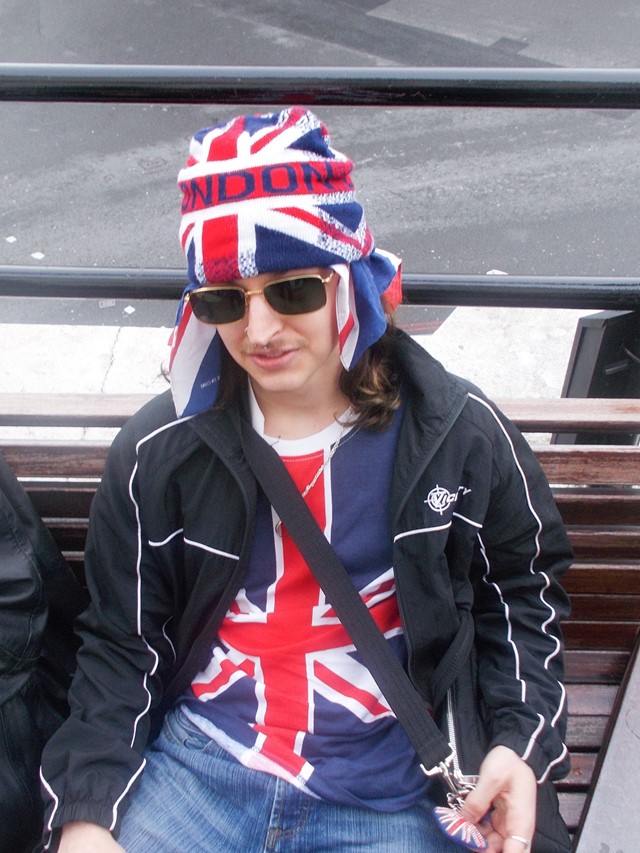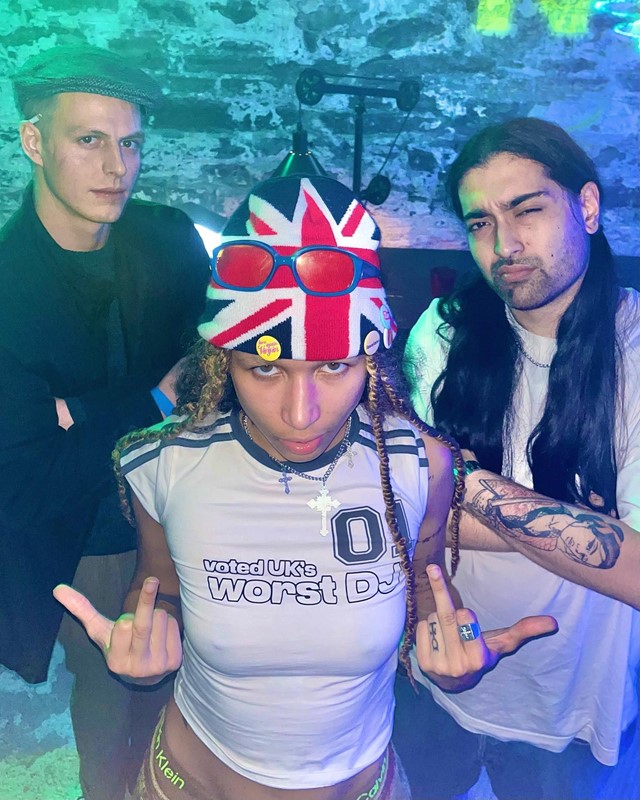Young people across the country are re-adopting the flag via souvenir shop cast-offs, but there might be more to the trend than just taking the piss
When you think of Union Jack fashion, a certain aesthetic probably springs to mind. A patriotic waistcoat here; a Kate Spade scatter cushion there; maybe even a floaty dress from Next. Over the last three decades we’ve often been told that Union Jack fashion can actually be “very cool” if “done in the right way”, yet the best example we can muster is a 30-year-old picture of a pop star in a minidress. Despite our greatest efforts as a society – and some may swing their skulls in disagreement – the Union Jack has never been wholeheartedly cool in the way people desperately want it to be. Which is exactly why young people today are giving it a reprise.
Up and down the country, Union Jacks are slowly trickling back into young people’s fashion lexicon, appearing on shrunken baby tees, beaten up messenger bags and knitted woollen beanies across the land. Far from runway ready, it’s souvenir shop tat that’s catching their eyes, whether they’re sitting outside a Yung Lean gig in London, walking the cobbled streets of Paris, or going for a stroll in Manchester’s Northern Quarter. An accouterment of second-hand cast-offs and Hello Kitty relics, it could be the Union Jack’s perceived cringe-ness that’s ultimately giving it back its bite, a patriotic symbol irony-pilled and sold back for a fraction of the price.
“My sweat bands are from a corner shop that also functions as a fancy dress store, and the T-shirt is a Bratz collaboration,” says art grad Bijou Gregory of her Union Jack outfit, emailing me pics of the fit. Not only were the attached items sufficiently patriotic for this piece, but their description perfectly encapsulated the frontlines of this trend: remnants from a local convenience store and the merchandise of a children’s doll. As well as this, for Bijou, dressing in the Union Jack has a hint of sarcasm. “As someone born into a female body, I feel like patriotic dress is mocking the negative sides of masculinity,” she added, hammering home the satirical element of what’s going on.

Within this resurgent style, there seems to be at least some sort of awareness that the Union Jack is cringe – it’s impossible for something to be ironically reappropriated without becoming uncool first. Though there are powerful examples of the flag’s use, remade by anarchist punks in 1970s Britain, it’s difficult not to look back at the last few decades of Union Jack fashion (see gallery above) without feeling a pang of embarrassment – which makes it ripe for irony-pilling. The proponents of ketamine chic re-embraced markers of 2010s cringe, and this seems to be a continuation of that, but instead of COMME des FUCKDOWN caps its nostalgia for a cultural epoch that apparently peaked with the London Olympics closing ceremony. Keelan Scott, a 20-year-old art student at Goldsmiths in London expressed similar sentiments, saying, “I like the irony of the style. I’m quite a jokey person and do think wearing something so blatantly British in London is humorous.” Keelan also has no time for actual patriotism, but admits they’d find it quite funny if “a seriously patriotic person thought I was on their side”.
But before this moment, there have been repeated attempts to tap into the Union Jack’s cultural cache in a more straightforward way. For better or worse, the flag hasn’t really exited fashion’s consciousness since the 1970s. There have been peaks and there have been troughs, like Liam Gallagher and Patsy Kensit nestled inside a red, white and blue bedspread on a 1997 cover of Vanity Fair (peak) or Taylor Swift wearing a tiny top hat during the British Invasion portion of the Victoria Secret show (trough). Andrew Groves, Professor of Fashion Design at Westminster University, notes that the former “coincided with the end of 18 years of a Tory government” which meant that “the semiotic symbols of Britain, in particular the Union Jack, were ripe for being reclaimed and reinterpreted in a very un-ironic way.” In that sense, the late-90s Cool Britannia movement (of which that Vanity Fair cover was a linchpin) is the reverse of our irony-pilled moment.
“Revival of the Union Jack in fashion is less about traditional patriotism and more about cultural reinterpretation” – Professor Andrew Groves
Back then, the Union Jack was embraced based on a genuine belief that things could actually get better, but now – even with a new Labour government – things don’t seem all that positive for young people in Britain, and a reflection of that is the flag’s ironic reinterpretation. As Groves goes on to say, “the revival of the Union Jack in fashion is less about traditional patriotism and more about its graphic appeal and cultural reinterpretation.” In other words, its meaning is constantly in flux. This then allows “new generations to reclaim and recontextualise the flag in ways that reflect contemporary British identity” – exactly what young people are doing today.
But though irony seems to be the obvious way young people are interacting with the flag, that’s not the case for everyone. Conor, a 21-year-old fashion student in Manchester, owns around seven or eight Union Jack pieces that he’s bought on Vinted, Depop and from charity shops. “Personally it has a bit of a nostalgic feel,” he says, “because when I was younger I had a Union Jack themed bedroom, and that’s where my obsession grew. I’m kind of always drawn to Union Jack themed pieces.” What’s interesting is the way that Conor incorporates the style into his wardrobe, which reflects the irony-pilled version of things, but is actually the opposite. In addition to that, after stating their ironic aims with their fits, Bijou also went on to add that a “joy in Brit pop aesthetics” also attracts them to the style. Even Doja Cat cosplaying as Ginger Spice at Wireless Festival this month seemed to be a full-throated, un-ironic embrace of the flag, with designer Dilara Fındıkoğlu posting the couture piece next to the caption “truly proud and grateful”, followed by a Union Jack emoji. Maybe, just maybe, all is not as ironic as it seems. Are people tapping into genuine nostalgia and making Union Jack fashion cool?

“What’s cool is I’m seeing lots of Black, POC and queer people doing it now,” says Rachel Chinouriri, the 25-year-old pop star. Like other Black British artists such as Nia Archives, Chinouriri has incorporated Union Jack iconography into her aesthetic, and she says it’s not for irony’s sake. “My entire album is based around what it’s like growing up being Black in Britain”, says the singer. “I remember first seeing the Brit pop aesthetic as a kid and thinking it was cool, but never felt like I could be a part of it because I never saw people who looked like me embracing it. Once I grew up and knew why, I was determined to be part of highlighting the cultural significance of what Black people have done for UK pop culture, and not allow its erasure.”
Another one of those Black British artists who reps the Union Jack is Lava La Rue. “I have noticed, on quite a shallow pseudo-Britpop, Oasis flex that there’s been a Union Jack resurface in fashion,” La Rue says, in a conversation over email. “It nearly put me off my own use of the iconography, but I continue to wear it because of a personal cause.” The artist explains how they’ve managed to attract the ire of both the left and right with their reappropriation of the symbol, used in combination with the Jamaican flag on their LAVALAND clothing line. The left – understandably, according to La Rue – take umbrage with the Union Jack’s “dark colonial past” and “morally corrupt government,” while the right hate that a queer, gender non-conforming POC sports a symbol that they claim is the antithesis of those identities. But like Chinouriri, La Rue continues to wear the Union Jack as a gesture of reclamation. “Why should we allow it to belong to the worst of the worst,” they say, “when there are so many undeniably British things that deserve to rep that flag too? Grime, the NHS, our British athletes and ballers. Is it not counterproductive to give up the symbol to the royalists and Tories?”
But in a roundabout way, the irony-pillers and reappropriators are doing the same thing, both mining the recent past for new meaning. Some revisit old markers of cringe, some rehash fond childhood memories, while others, like the POC adopters, forge new meaning from a symbol that they were constantly told was not theirs. As Groves puts it “the Union Jack holds a broad range of cultural meanings, both positive and negative, allowing it to be continually reinterpreted and reclaimed.” Despite the different reasons, the current trend taps into a kind of souvenir shop aesthetic that came about in the late 2010s, which is itself a callback to a simpler time, of patriotic trinkets on family holidays and trips into central London (whether you lived in the capital or not). So, really, beneath those layers of irony, those adopters are still taking part in a wholly nostalgic endeavour, whether they mean to or not. The Union Jack’s appearance on baby tees and beanies up and down the country may come with a wink and a nudge, but really it’s nostalgia that did it, and it comes for us all in the end.
